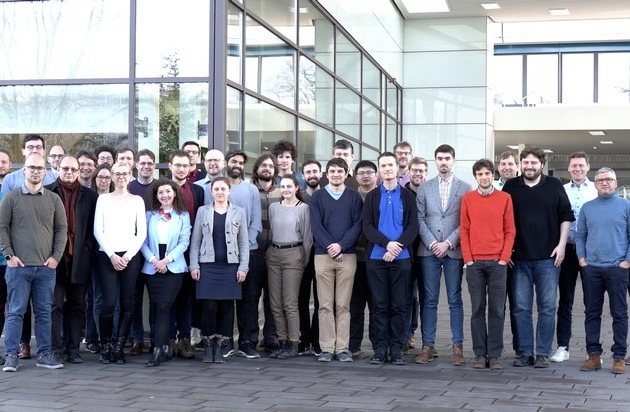In January 2024, a new Horizon Europe-funded project began that aims to significantly advance research in the field of solid-state-based quantum computing. The SPINUS project aims to create experimental platforms based on solid-state qubits for quantum simulations and quantum computers. The project addresses important aspects of these platforms and is distinguished by its comprehensive approach, focusing on materials design, control technologies, and readout technology, as well as specifically designed quantum algorithms.
Over the past decade, various system architectures for quantum simulations have been developed based on a wide range of approaches, including ultracold neutral atoms, ion traps, Rydberg atoms, photonic systems, and superconducting circuits. Although significant progress has been made in all fields, a fundamental challenge remains: it is still impossible to create large-scale quantum simulators that can be effectively designed, configured, and controlled to explore complex aspects of quantum many-body dynamics.
One promising approach to quantum computing is the use of so-called nitrogen vacancy (NV) centers in diamond. Their unique properties – stable and controllable quantum states at room temperature – have been demonstrated in pioneering experiments. In order to exploit this potential, the SPINUS project draws on the latest developments in electronic and nuclear spin networks, solid-state quantum simulators and computers in order to advance this technological approach towards scalable solid-state systems. doctor. “The ability to operate NV cores at room temperature sets them apart from other quantum computer architectures,” concludes Martin Copenhofer, “SPINUS” project coordinator at Fraunhofer IAF. “We look forward to further developing this platform technologically and demonstrating quantum simulations and quantum computations on even larger scales.” .
What also distinguishes »SPINUS« is its comprehensive and collaborative approach to projects as well as its innovative concepts and methods. SPINUS aims to promote achievements in the field of quantum technologies and complement existing institutions in this field by working closely with associated startups and other research projects in the quantum computing ecosystem. “We want to have a lasting impact in the field of quantum technologies and contribute to the development of large scale quantum systems in Europe by pushing the boundaries of what is currently possible,” emphasizes the doctor. Daniel Hahnel, Head of Quantum Technologies at Fraunhofer IAF.
Spin-based quantum simulations with more than 50 quantum units
To develop advanced quantum simulator platforms that can harness the benefits of quantum physics across a wide range of use cases, improvements in system size, controllability, and programmability are essential. As part of SPINUS, researchers will go beyond the state-of-the-art in all these fields based on three different types of quantum simulation models: 3D nuclear spin simulation (application: floc phases, spin diffusion), and 3D electron spin simulation (application: Floc phases, spin diffusion), 3D electron spin simulator (application: open systems, irregular and highly connected systems), 2D nuclear spin simulator (application: spin fluid, topological phases, Heisenberg models, Kitaev models, spin diffusion). The goal is to develop experimental platforms for quantum simulation with more than 50 quantum units.
All simulators are based on the same premise: interacting and controllable spin networks in diamond and silicon carbide (SiC), exploited using optically active defects. Each simulator uses different rotation configurations (e.g., 2D vs. 3D, or naturally irregular vs. ordered) to adapt the simulator to specific applications.
Spin-based quantum computing with more than 10 qubits
SPINUS aims to improve quantum computing platforms based on NV cores by increasing the number of usable qubits in quantum computers to more than 10 qubits. To this end, the consortium will create coupled arrays of NV cores while maintaining and improving the quantum gate accuracy to more than 99.9%. The researchers will also develop photoelectric NV magnetic resonance (PDMR) detection and selective readout technology to overcome the current bottleneck of selectively processing larger numbers of qubits than optical techniques. The resulting platforms aim to enable universal quantum computation based on two-qubit gate operations facilitated by controllable dipole couplings between neighboring NV cores.
In addition to the technical challenges of scaling up NV-based quantum computers, the necessary hardware and software infrastructure needs to be developed. This includes developing improved methods for controlling and reading the quantum state of qubits, which is crucial for achieving high-quality gates and accurate measurements. Another critical factor is the performance of quantum algorithms for different use cases, both at the algorithmic level and in terms of their implementation on a spin-based computing platform.
While individual partners in the consortium have already made significant research efforts in this direction, SPINUS will jointly address challenges in the areas of materials design, control, readouts, device characterization and quantum algorithms in order to develop quantum computing platforms based on NV cores.
About the “Spinos” project
SPINUS is coordinated by the Fraunhofer Institute for Applied Solid State Physics (IAF) and benefits from a total of 12 international partners whose expertise includes experimental implementation of solid-state quantum simulators, room-temperature spin-based quantum computers and scalable diamond arrays. Qubit.
The project is funded by the European Union's Horizon Europe research and innovation program and will last for four years. The consortium consists of: Fraunhofer Society for the Promotion of Applied Research. V. for their institute Fraunhofer IAF, University of Ulm, Danmarks Tekniske University, University of Stuttgart, Forschungszentrum Jülich GmbH, Universiteit Hasselt, Linkopings Universitet, Technische Universiteit Delft, Wigner Fizikai Kutatokozpont, Fondazione Bruno Kessler, Quantum Brilliance GmbH and AMIRES SRO.
This project is funded by the European Union as part of the research and innovation program “Horizon Europe” under funding agreement No. 101135699.
Fraunhofer-Institut für Angewandte Festkörperphysik IAF Tullastraße 72 | 79108 Freiburg
Lukas Kübler Marketing und Kommunikation +49 761 5159-261 www.iaf.fraunhofer.de

“Subtly charming coffee scholar. General zombie junkie. Introvert. Alcohol nerd. Travel lover. Twitter specialist. Freelance student.”







More Stories
Xiaomi: Android 15 is now available for these devices
Billionaire wants to save space telescope – NASA is skeptical
“Lian Li’s infinity mirror effect is really amazing.”